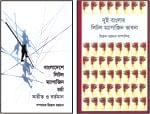A tale of little magazines

Bangladeshey Little Magazine Chorcha
Otit O Bartoman
Ed. Mizan Rahman
Kathaprokash
....................
Dui Banglar Little Magazine Bhabna
Ed. Mizan Rahman
Kathaprokash
What is a little magazine and why is it there? What is its history and who first brought it out? Before getting into the answers let us first see the definition of little magazines. It goes like this ? a periodical, usually not published for profit, prints reviews, essays, fiction, or poetry or more usually some combination of them, supposedly devoted to high literary standards. Little magazines often run innovative or experimental works. A few little magazines pay for contributions, many do not. Some are widely influential, but others are virtually unknown except to the editors and contributors. Little magazines may be very helpful to a new writer who is selective in sending submissions.
The publicity and expansion of little magazines began mainly at the turn of the twentieth century. But its real journey started in the mid-nineteenth century. The Dial, (Boston, 1840-1844), jointly edited by Ralph Waldo Emerson and Margaret Fuller, is considered as the original model. At the end of the nineteenth century and in the beginning of the twentieth, little magazines became popular in England, France and America through the imagist, symbolist and other movements. In Bengali literature, Promoth Chowdhury's Sobujpatra (1914) is thought to be the original model for little magazines. Other than that, Bankim Chatterjee's Bangodarshan (1872) is also a point of reference.
Mizan Rahman, a young promising poet, researcher and editor of a little magazine, has edited two books regarding little magazines in Bangladesh and thoughts around little magazins in the two Bengals. Undoubtedly, this is a pioneer work and these books are first in linking the two Bengals. Bangladeshey Little Magazine Chorcha, Otit O Bartoman (Little Magazine Practice in Bangladesh, Past and Present) is divided mainly into three parts. In the first part of the book come write-ups on the subject of little magazine practice, in the past and present, in Bangladesh. Ahmaad Majhar has written here of Dhaka based little magazine practice and activities. We come to know from his write-up that the little magazine wave came up in Bangladesh strongly in the 1960s. Saptak (1962), Baktabbya (1963), Swakkhor (1963), Sad Generation (1963), Samprotik (1964), Kanthoswor (1965), Chhotogalpo (1966) and several other little magazines caused a big movement in the field of little magazines in Dhaka. And it is to be noted that Abdullah Abu Sayeed's Kanthoswor played a vital role then. The magazine was published continuously for twelve years. Kanthoswor was a strong voice of the emerging litterateurs of our country, most of whom are well-known names in Bengali literature today. The second part, named as supplement, includes several renowned litterateurs' write-ups on little magazines. The writers include Buddhadev Bose, Shibnarayan Roy, Subimol Mishra, Robin Ghosh and so on. And in the third part is a list of nearly all little magazines published throughout Bangladesh.
Dui Banglar Little Magazine Bhabna (little magazine thinking in two Bengals) is a compilation of write-ups regarding little magazine thoughts of several litterateurs from the two Bengals, eleven from each. In the writers' list there are not only renowned litterateurs but young emerging litterateurs as well.
From these books it becomes clear that the little magazine is the real ground for rearing future writers. It is the best territory for all kinds of experiments in literature. Newspapers, magazines are nothing but institutions. They do not bring up a writer. Moreover, like taking the cream from the milk, they collect good writers from little magazines. We also come to know of the significant characteristics of little magazines. For instance, little magazines are not traditional and popular.
Most writers in little magazines are young and new comers in literature. Loss is the common word in the dictionary of little magazines. Anyone who wants to publish a little magazine does so at risk of financial loss. On the other hand, if a little magazine becomes profitable it soon loses its characteristics. The most striking character of little magazines is they cannot survive more than a few years.
It can be said that Mizan Rahman has done extraordinary work regarding little magazines. They deserve to be studied seriously.
Rahad Abir is a teacher and journalist .

 For all latest news, follow The Daily Star's Google News channel.
For all latest news, follow The Daily Star's Google News channel. 



Comments